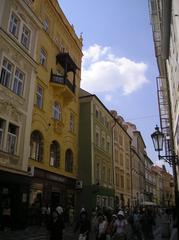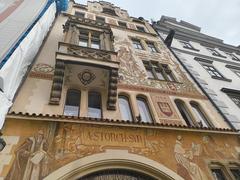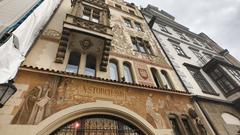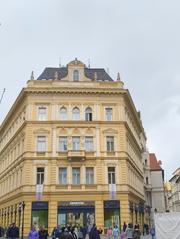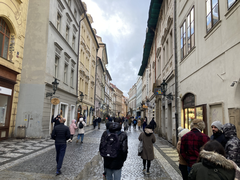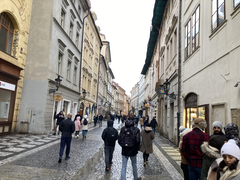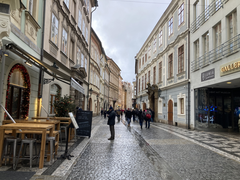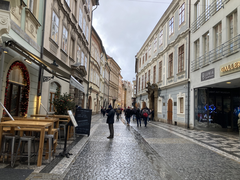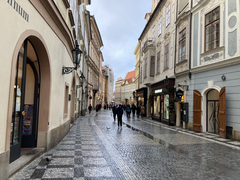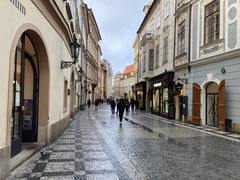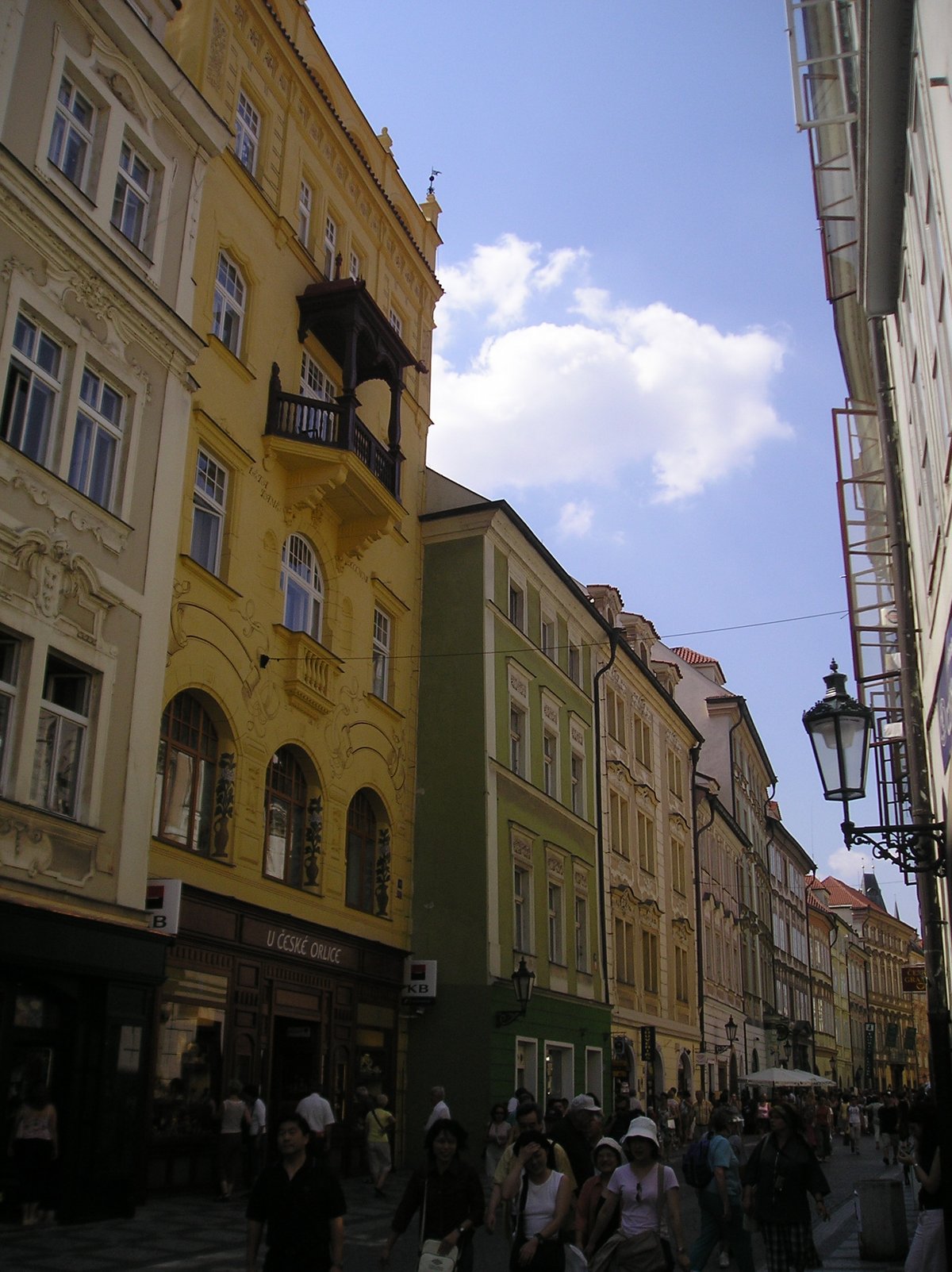
Celetná Street Prague: Visiting Hours, Tickets, and Historical Sites Guide
Date: 14/06/2025
Introduction: Celetná Street and Its Historical Significance
Celetná Street, nestled in the heart of Prague’s Old Town, stands as one of the city’s most historically and architecturally significant thoroughfares. Originating in the 14th century and named after “calty,” a traditional plaited bread once baked and sold here, Celetná has long been a hub of local trade and daily life (Prague FM, Nomads Travel Guide). It forms a crucial segment of the historic Royal Route (Královská cesta), the ceremonial path used by Bohemian kings for their coronation processions to St. Vitus Cathedral at Prague Castle, embedding Celetná deeply into Czech political and cultural heritage (Visit Prague Info, Prague Guide).
Celetná’s architectural diversity offers a journey through time: Romanesque cellars, Gothic and Baroque façades, and the renowned Cubist House at the Black Madonna, a 1912 masterpiece by Josef Gočár (Prague.net, Nomads Travel Guide). Distinctive house signs—like the Golden Angel and Black Madonna—reflect Prague’s urban traditions before numbered addresses.
Home to notable residents such as Franz Kafka and Mozart’s hostess Josepha Dušková, Celetná remains a vibrant pedestrian zone. Today, it invites visitors to explore its cobbled lanes, museums, and cafés throughout the year, making it a must-see destination for history lovers, architecture fans, and casual travelers (Prague Guide, Prague.net). This guide will provide you with essential information on Celetná’s history, landmarks, visiting hours, ticketing, accessibility, and tips to enhance your experience (Prague.eu, Qeepl).
Table of Contents
- Introduction
- Medieval Origins and the Royal Route
- Architectural Evolution
- Notable Residents
- Commercial and Social Life
- Institutional and Cultural Sites
- Visiting Celetná Street
- Visuals and Media
- Frequently Asked Questions (FAQ)
- Conclusion and Resources
Medieval Origins and the Royal Route
Early History and Name Origin
Celetná is among Prague’s oldest streets, with records dating to the 14th century. Its name is derived from “calty” or “calta,” a plaited pastry that reflects its medieval commercial roots (Prague FM, Prague Guide).
The Royal Route (Královská cesta)
Celetná was central to the Royal Route, the ceremonial procession path for Bohemian kings. The route began at Vyšehrad, crossed Celetná, and culminated at Prague Castle’s St. Vitus Cathedral. This tradition cemented the street’s role in royal and civic life (Visit Prague Info, Prague Guide).
Architectural Evolution
Romanesque Foundations
Romanesque cellars from the 12th–13th centuries remain beneath Celetná, many now used as wine bars and restaurants, offering a glimpse into Prague’s distant past (Prague Guide).
Gothic and Baroque Influences
Above ground, you’ll find a blend of Gothic and Baroque facades. Notable buildings include the parsonage at Celetná 5/601 and the House At the Three Kings (Celetná 3/602), with 14th-century Gothic elements (Prague Guide).
Cubist Landmark: House at the Black Madonna
The House at the Black Madonna, designed by Josef Gočár in 1912, is a rare Cubist building housing the Czech Museum of Cubism and the Grand Café Orient (Visit Prague Info, Prague.net).
Notable Residents and Cultural Figures
- Franz Kafka: Lived at House At the Three Kings (Celetná 3).
- Josepha Dušková: Mozart’s hostess, lived at House At the Black Sun (Celetná 8).
- Bernard Bolzano: Philosopher, resided at House At the Four Columns (Celetná 25) (Prague.net).
Commercial and Social Life
Celetná has been a bustling trade route since medieval times, home to bakers, merchants, and craftsmen. Today, shops, boutiques, and cafés line the street, continuing its vibrant commercial legacy (Prague.net, Prague Guide). Historic house signs like the Golden Angel and Black Madonna, predating numbered addresses, remain visible and add to the street’s charm.
Institutional and Cultural Significance
- Charles University: Historic buildings like Buquoy Palace (No. 20) and House At the Vulture (No. 22) serve university functions (Prague.net).
- Mint House: An 18th-century Baroque structure once served as the city’s military headquarters (Prague Guide).
- Divadlo v Celetné: The street’s theatre (Manhart House, No. 17) continues its cultural traditions (Prague.net).
Visiting Celetná Street
Visiting Hours and Accessibility
Celetná is a pedestrian street open 24/7. Shops and museums typically operate from 9:00 AM to 7:00 PM, but hours may vary. The street is mostly flat and accessible, though cobblestones may pose challenges for some.
Tickets and Entry Fees
Walking Celetná is free. Attractions like the House at the Black Madonna museum require tickets (usually around 150 CZK), available onsite or online.
Guided Tours and Events
Several walking tours include Celetná, focusing on its historical and architectural significance. Seasonal events and festivals also take place here.
Visitor Tips
- Visit early or late in the day to avoid crowds.
- Explore Romanesque cellars for a unique dining experience.
- Don’t miss the House at the Black Madonna for a Cubist architecture highlight.
Nearby Attractions
Celetná connects the Powder Tower to Old Town Square, placing it near:
- Old Town Square and the Astronomical Clock
- Powder Tower (Prašná brána)
- Estates Theatre
- Prague Castle (within walking distance)
Visuals and Media
- Include photos of Celetná’s facades, the House at the Black Madonna, and historic signage.
- Use alt text such as “Celetná Street Prague historic buildings” or “Cubist House at the Black Madonna.”
- Consider embedding interactive maps or virtual tours.
Frequently Asked Questions (FAQ)
Q: What are Celetná Street’s opening hours?
A: The street is open 24/7; business and museum hours are generally 9:00 AM–7:00 PM.
Q: Is there an entry fee?
A: Walking the street is free. Museums or attractions may charge admission.
Q: Are guided tours available?
A: Yes, many guided tours include Celetná Street.
Q: Is Celetná Street accessible for wheelchairs?
A: The street is flat but paved with cobblestones. Some venues may have limited accessibility.
Conclusion and Call to Action
Celetná Street is a living tapestry of Prague’s history, architecture, and urban culture. Its central location, architectural gems, and vibrant street life make it an essential stop for anyone visiting Prague. For enhanced exploration, consider joining a guided tour or using the Audiala app for audio-guided walks. For the latest updates, events, and detailed travel resources, visit the official Prague tourism website and follow us on social media.
References
- Prague FM: Celetná Street
- Prague Guide: Celetná Street
- Visit Prague Info
- Prague.net: Celetná Street
- Nomads Travel Guide
- Qeepl: Top 10 Most Beautiful Streets in Prague
- Prague.eu: Official Tourism Site
